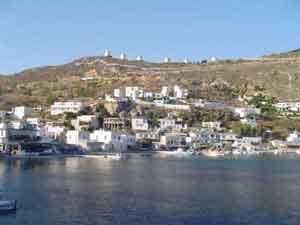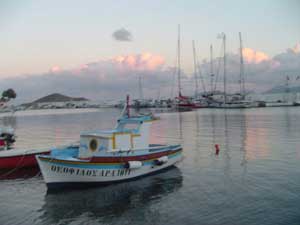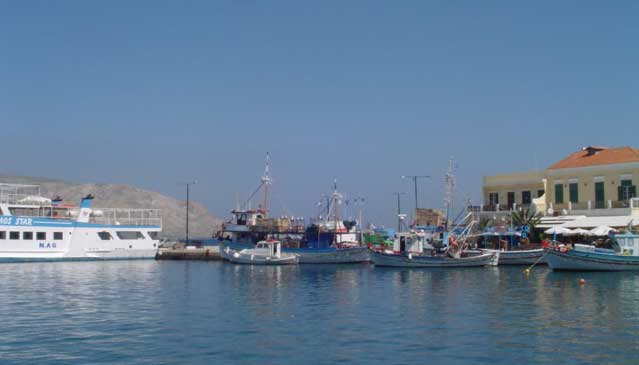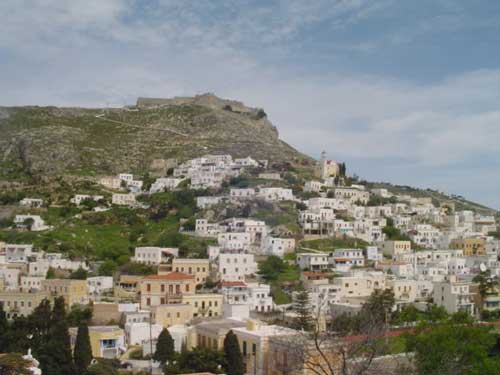.
Administrative Region : North Aegean
Regional unit : Kalymnos
Leros (Greek: Λέρος) is a Greek island and municipality in the Dodecanese in the southern Aegean Sea. It lies 317 km (171 nautical miles) from Athens's port of Piraeus, from which it can be reached by an 11-hour ferry ride (or by a 45-minute flight from Athens). Leros is part of the Kalymnos peripheral unit. The island has been also called in Italian: Lèro and in Turkish: İleriye.


Leros Panteli
Geography
The island is 74 square kilometres (29 sq mi) and has a coastline of 71 km (44 mi). The municipality includes the populated offshore islands of Pharmakonisi (pop. 74), Levitha (8), and Kinaros (2), as well as several uninhabited islets, and had a 2001 census population of 8,207, although this figure swells to over 15,000 during the summer peak. It is known for its imposing medieval castle of the Knights of Saint John possibly built on a Byzantine fortress. Nearby islands are Patmos, Lipsi, Kalymnos, and the small islands of Agia Kyriaki and Farmakos. In ancient times it was considered the island of Parthenos Iokallis and linked to the Hellenistic and Roman literature on Meleager and the Meleagrides. The administrative center and largest town is Agia Marina, with a population of 2,672 inhabitants. Other sizable towns are Lakkíon (pop. 1,990), Xirókampos (908), Kamára (573), and Álinda (542).

Leros, Port of Agia Marina
History
Antiquity
Thucydides stressed the special importance of the bays and the harbours of Leros during the Peloponnesian War (431 BC – 404 BC), where Leros supported the democratic Athenians. After the end of the war Leros came under the sovereignty of the Spartans. The island had a famous sanctuary of the goddess Artemis.[1]
It then followed the fate of the rest of the Dodecanese Islands during the years of Alexander the Great and his successors, the Roman years and the Byzantine period. After the division of the Roman Empire, it, like all of Greece, was ruled from Constantinople, capital of the Eastern Roman Empire. On the island of Farmaco east from Leros, a few miles from Didyma on the Turkish coast, Julius Cesar was held as a hostage by local pirates for forty days.
Venetian and Ottoman Era
The church of Agia Marina.
During the Byzantine Age, the island was incorporated into the Theme of Samos. During the thirteen century, the island was occupied by the Genoese and then by the Venetians. In the year 1309, the Knights of St John seized and fortified Leros. In 1505, the Ottoman Admiral Kemal Reis, with three galleys and other seventeen warships, besieged the castle but could not capture it. The operation was repeated in 1508 with more ships, but again nothing was achieved.
Legend has it that then the island was rescued by the only surviving knight, barely 18 years old. He dressed women and children with the armor of the dead defenders, convincing the Ottomans that the garrison of Leros was still strong. Finally, on 24 December 1522, following the siege of Rhodes, a treaty was signed between Sultan Suleiman and the Grand Master of the Knights, Philippe Villiers de L'Isle-Adam, and Leros, along with all the Aegean possessions of the Order, passed into Ottoman hands which ruled the island with brief interruptions during a period of four hundred years.
View of the castle of Leros.
During the Ottoman rule, and along with the other islands, Leros enjoyed a privileged regime, with partial autonomy and self–government. During the Greek Revolution of 1821, the island was liberated and became an important base for the re-supplying of the Greek Navy. Administratively, it came under the jurisdiction of the Temporary Committee of the Eastern Sporades.
With the Treaty of London, on 3 February 1830, however, which determined the borders of the newly–established Greek state, the freed islands of the Eastern Sporades were given over to the Ottoman Empire again. In the "Diary of the Prefecture of the Archipelago" of 1886, Leros, along with the islands of Patmos, Lipsos and Fournoi, belonged to the Ottomans. The island's administrative council was made up of both Greeks and Turks.

Platanos, Castke of (Kastro Panagias) on the Hill Apitiki
The Italian Period
In 1912, during the Libyan War against the Ottoman Empire, the Italians occupied all of the Dodecanese islands (except Kastelorizo). On May 12, 1912 the island was seized by the sailors of the Italian Navy cruiser "San Giorgio". The Greek inhabitants of the islands declared the autonomy of the islands under the title "The Aegean State", with the aim of unification with Greece, but with the outbreak of the First World War, these moves came to nothing, and the Italians retained control of the islands.
The promenade of Lakki.
From 1916 to 1918, the British used Leros as a naval base. In the Venizelos-Tittoni Agreement of 1919, the island was to be returned to Greece, along with all of the Dodecanese except Rhodes, but after the Greek defeat in the Greco-Turkish War the Italians canceled the agreement. As a result, the Treaty of Lausanne confirmed the Italian possession of Leros and the Dodecanese.
The new Italian Fascist regime actively attempted to Italianize the Dodecanese, by making the Italian language compulsory, giving incentives to locals to adopt the Italian nationality, and clamping down on Greek institutions. In the 1930s a new model town, Portolago, was built by the Italian authorities. It is one of the best examples of Italian Rationalist architecture. The Greeks later renamed it Lakki.
During the 31 years that the Italians remained in Leros, they set up a great plan to build and fortify the island, since its strategic position and its large natural harbours (the largest of which, Lakki, is the largest deep water harbour in the Mediterranean Sea), made it an ideal naval base. The fortification of Leros and the creation of a major naval base at Lakki, ensured that the Italians had control over an area of vital interest to the Allies (the Aegean, the Dardanelles and the Near East). Mussolini, who called Leros "the Corregidor of the Mediterranean", saw the island as a crucial base for the Italian domination of the eastern Aegean Sea, and even built a mansion for himself in the town of Portolago.
World War II
Main articles: Dodecanese Campaign and Battle of Leros
From 1940, when Italy entered the Second World War on the side of Germany, Leros suffered bombing raids by the British Royal Air Force. As a result of the excellent anchorage provided to warships by the many natural coves, the island was the second most bombed during World War Two (after Crete).[CN] On 8 September 1943, as Italy could not continue the war on the German side, it signed an armistice and came over to the Allied camp. After the Italian armistice, British reinforcements arrived on Leros and other Dodecanese islands and the island suffered continuous German aerial bombardment. One of the largest attacks was on the Greek Navy's flagship, the Queen Olga, sunk by German bombers on Sunday September 26, 1943, along with HMS Intrepid, while they were anchored in Portolago. The island of Leros was finally captured by German troops during operation Taifun in airborne and amphibious assaults between 12-16 November 1943. The forces involved were paratroop units and a battalion from the elite Brandenburg division. The ground troops were supported by bombers of the "Luftwaffe". Among them I. and II. group of Stuka-Wing 3. I. Group operated from Megara Air Base. The island remained under German occupation until the end of the war.
Post-war history
After the Germans evacuated the island, it came under British administration, until, on 7 March 1948, together with the other Dodecanese Islands, Leros was united with Greece. Approximately 700 years after the end of Byzantine rule, the Dodecanese was incorporated into the Greek State. During the post-war years the Greek governments used many buildings in Leros for various reasons. In 1959, the mental hospital of Leros was founded, whose original primitive conditions have been improved. During the junta of the Colonels, the island was used as a place of internal exile for political dissenters,[2] with old Italian barracks of the island used as a concentration camp.
In 1989 Leros came to Europe-wide attention as a result of a scandal involving embezzlement of funds and the maltreatment of about 3,000 mental patients at an institution on the island. Funding and increased monitoring by the EU led to a rapid and substantial improvement in conditions. A June 2009 BBC report suggests these improvements have not all been sustained.[3]
Notable people
Georgios Roussos, lawyer and politician[4]
Santino Christos Niarchos, investor/shipping magnate, the great-nephew of Stavros Niarchos.
Transportation
Leros has an Airport at Partheni that connects daily the island with Athens. There are also ferry connections to and from Pireus and the other islands of the Dodecanese. The Catamaran Dodekanissos Express and the Hydrofoils (only during the summer) connect Leros with most of the Dodecanese islands. For those who want to visit Leros the alternative way to Ferry travel (8–10 hours) is to fly to Athens and then fly to Leros with domestic flight or fly direct to Kos and then to Leros by boat (1 – 2 hours).
Traditional Music
Many local songs of Leros are among the most famous among the traditional Music of Greece: among the most famous are Pote tha'nixoume pania, Mes tou Aegeou ta Nisia and proutzos.
Division of the municipality of Leros
- Leros / Δ.δ. Λέρου [ 8.207 ]
- Agia Marina / η Αγία Μαρίνα [ 2.672 ]
- Alinda / τα Άλινδα [ 542 ]
- Archangelos (island) / ο Αρχάγγελος (νησίδα) [ 0 ]
- Velona (island) / η Βελόνα (νησίδα) [ 0 ]
- Glaros (island) / ο Γλάρος (νησίδα) [ 0 ]
- Gourna / η Γούρνα [ 292 ]
- Drymon / ο Δρυμών [ 212 ]
- Kamara / η Καμάρα [ 573 ]
- Kinaros (island) / η Κίναρος (νησίδα) [ 2 ]
- Kokkali / η Κόκκαλη [ 154 ]
- Lakkion / το Λακκίον [ 1.990 ]
- Levitha (island) / τα Λέβιθα (νησίδα) [ 8 ]
- Mavra (island) / τα Μαύρα (νησίδα) [ 0 ]
- Megalo Livadi (island) / το Μεγάλο Λιβάδι (νησίδα) [ 0 ]
- Xirokampos / ο Ξηρόκαμπος [ 908 ]
- Parthenion / το Παρθένιον [ 240 ]
- Piganoussa (island) / η Πηγανούσσα (νησίδα) [ 0 ]
- Plaka (island) / η Πλάκα (νησίδα) [ 0 ]
- Plakes / οι Πλάκες [ 143 ]
- Stongyli (island) / η Στρογγυλή (νησίδα) [ 0 ]
- Temenia / τα Τεμένια [ 397 ]
- Trypiti (island) / η Τρυπητή (νησίδα) [ 0 ]
- Farmakonision (island) / το Φαρμακονήσιον (νησίδα) [ 74 ]
- Agia Marina / η Αγία Μαρίνα [ 2.672 ]
See also
List of islands of Greece
References
^ "Leros". Catholic Encyclopedia. New York: Robert Appleton Company. 1913.
^ "Lakki is the largest of the four detention camps for men and women with Communist backgrounds who were arrested after the April 1967 military takeover." "Political Prisoners in Greece Issue Plea". New York Times: p. 7. 1970-01-03.
^ "Greek mental care failures exposed". BBC News. 30 June 2009. Retrieved 7 May 2010.
^ Επίτομο Γεωγραφικό Λεξικό της Ελλάδος (Geographical Dictionary of Greece), Μιχαήλ Σταματελάτος, Φωτεινή Βάμβα-Σταματελάτου, εκδ. Ερμής, ΑΘήνα 2001
Hans Peter Eisenbach (2009) Fronteinsätze eines Stuka-Fliegers, Mittelmeer und Ostfront 1943-1944. Germany Helios Verlag ISBN 978-3-938208-96-0. 18,50 €uro. The book describes exactly the Stuka missions of I. StG 3 against Leros and Samos and against the Royal Navy in 1944. The book is based on the flight log book of a stuka pilot.
|
The Dodecanese Islands Agathonissi | Koubelonisi | Stroggyli | Farmakonisi | Arkoi | Kalovolos | Agreloussa | Anydros Patmou | Patmos | Hiliomodi Patmou | Tragonisi | Arefoussa | Leipsoi | Megalo Aspronisi Leipson | Makry Aspronisi Leipson | Kouloura Leipson | Makronisi Leipson | Halavra | Imia | Fragos | Arhangelos | Faradonesia | Leros | Piganoussa | Pitta | Megalo Glaronisi | Mikro Glaronisi | Kalymnos | Kalolimnos | Kalavros Kalymnou | Telendos | Nero | Safonidi | Plati Pserimou | Pserimos | Levitha | Mavra Levithas | Glaros Kinarou | Kinaros | Kos | Gyali | Nisyros | Pergoussa | Paheia Nisyrou | Kandeloussa | Tilos | Antitilos | Gaidourosnissi Tilou | Seirina | Mesonisi Seirinas | Adelfoi Syrnas Islets | Kounoupoi | Koutsomytis | Hondro | Astypalaia | Fokionissia | Pontikoussa | Symi | Nimos | Marmaras | Kouloundros | Plati Symis | Sesklio | Chalki | Agioi Theodoroi Halkis | Alimia | Makry Halkis | Prasouda | Rhodos | Strogulli Kritinias | Htenies | Karavolas Rodhou | Prasonissi Rodhou | Megalo Sofrano | Mikro Sofrano | Astakida | Kamilonisi | Saria | Karpathos | Kasos | Armathia | Makronissi Kassou | Rho | Kastellorizo (Megisti) | Stroggyli Kastellorizou |
| Ancient Greece
Science, Technology , Medicine , Warfare, , Biographies , Life , Cities/Places/Maps , Arts , Literature , Philosophy ,Olympics, Mythology , History , Images Medieval Greece / Byzantine Empire Science, Technology, Arts, , Warfare , Literature, Biographies, Icons, History Modern Greece Cities, Islands, Regions, Fauna/Flora ,Biographies , History , Warfare, Science/Technology, Literature, Music , Arts , Film/Actors , Sport , Fashion --- |
Retrieved from "http://en.wikipedia.org/"
All text is available under the terms of the GNU Free Documentation License


